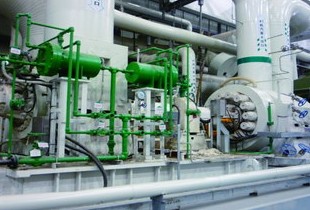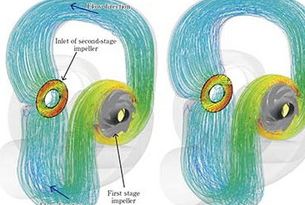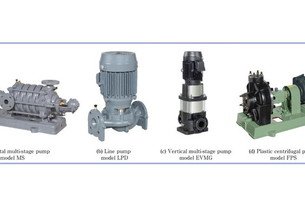Issue No. 251〔Special edition〕
Under the Scenes of our Lives High pressure Pump
- Role and Application -
Author
Tadashi KONDO
Fluid Machinery & Systems Company
High-pressure pumps, rarely seen in our everyday life, are working hard in places for producing unexpected familiar things as well as materials for such things.
High-pressure Pumps and Our Lives
If a pump engineer were asked “What is a highpressure pump?” he or she would probably answer“ It is a high-head pump.” Depending on what area people are involved in, they probably imagine different structures of high-pressure pumps.
If you search for high-pressure pumps on the internet, you will find positive-displacement or centrifugal pumps with different structures depending on the application. You will even find bicycle pumps. This suggests that with no particular definition given for them, different pump manufacturers name their pumps differently depending on the application.
In the first place, pumps play an active role in a countless variety of areas. Typical examples rather connected with our everyday life include areas like water supply and sewerage, agriculture, and draining for flood prevention. Perhaps, even ordinary people can easily imagine that pumps are used for these applications. However, almost no high-pressure pumps are used for these applications.
High-pressure pumps are unfamiliar in our everyday life, and are only seen during a factory tour or the like. However, the applications they can effectively work for are largely indispensable to our daily lives; with an important mission, they are actively working in these areas. They are, so to speak, an unsung hero. This article outlines high-pressure pumps so that you may feel a little more familiar with the high-pressure pumps from Ebara.
Applications of high-pressure pumps
To produce electricity, which we unconsciously use every day, boiler feed pumps designed for power generation are used. In steelworks, which produce steel plates used for washing machines and automobiles, descaling pumps are actively working.
In addition, high-pressure pumps are used in plants producing urea fertilizers for farm products such as radishes and carrots, petrochemical plants producing raw materials for plastics and synthetic fibers, and desalination plants producing drinking water from seawater. Power recovery turbines (reverse pumps*1) which help save energy are another application.
In many of these places, high-pressure pumps are used to feed water and/or chemical liquids to the pressurized environment or to flow water using pressure. The following paragraphs introduce three typical highpressure pumps that play an active role in thermal power plants, steelworks, and desalination plants.
*1: By utilizing, instead of reducing, the pressure no longer needed in a plant, the pump connected to the back of a motor works to produce a backflow to yield rotation assisting the motor drive, contributing to saving energy. The action is something like helping a bicycle move up a slope by pushing from behind.
Areas where high-pressure pumps are needed
(1)Boiler feed pump (BFP) for power generation

Fig. 1 50% capacity boiler feed pump (BFP) playing an active role
in a 1000 MW thermal power plant

Fig. 2 Flow of thermal power generation and a boiler feed pump
(2)Descaling pump
High-pressure pumps are also deeply involved with the manufacturing of washing machines, refrigerators, automobiles, etc., which are around us in everyday life.
As a material for the body of the above structures, steel plates are produced in steelworks. Steel ingots, the raw material of steel plates, are heated to 1 000 °C or higher. Then, while being conveyed on a roller conveyor, they pass through a giant rolling mill many times to be gradually decreased in thickness before they become steel plates.
On the surface of a steel ingot heated to high temperature, oxidized scales form. If the steel ingot is milled with oxidized scales remaining on the surface, the scales remain as impurities in the steel plates produced, which compromise the appearance and cause cracks, resulting in inferior products. To avoid this, immediately before a steel ingot enters a rolling mill,
The high-pressure water is produced by a descaling pump (Figure 3). When a steel plate has passed a rolling mill, water is no longer sprayed. This can be achieved by two different operating methods: one method repeatedly switches between high and zero flows of water without changing the pump rotation and the other method abruptly changes the rotation speed between 20% and 100% using an rapid-variable-speed fluid coupling, a proprietary device of Ebara. When a large amount of steel plates must be produced, the water spraying process is repeated several times per minute; either method is extremely tough for pumps.

Fig. 3 Steel plate manufacturing process and a descaling pump
(3)Desalination pump
In the Middle East and other areas where water shortage is a serious problem, they turn seawater into fresh water (plain water) to use it as drinking water, for example. This process is called desalination.
Among several ways of desalination, mainstream are the multistage flashing method and reverse osmosis (RO) method. The former method collects steam by vaporizing seawater, which uses a low-pressure vertical pump. The latter obtains fresh water by using a high-pressure pump to pass high-pressure seawater through a special fiber (RO technology) developed by a fiber maker in Japan. It consumes less energy and requires no large equipment. In combination with improvements in RO technology, this method is increasingly used in many applications in recent years (Figure 4). Among the large desalination plants in Japan, those in Okinawa and Fukuoka Prefectures use equipment based on this technology.
Due to handling seawater, each pump is made of highgrade stainless steel with a high corrosion resistance.

Fig. 4 Desalination plant and a volute-type, horizontal axially-split-casing, multi-stage pump
Applications of high-pressure pumps and models from Ebara
Although you can hardly see high-pressure pumps actively working, they play an active role in producing many things used in our everyday life.
Ebara has a portfolio of high-pressure pumps for these applications. Among them, four basic types are listed in the Table that follows. Out of the boiler feed pump line for power generation, we provide model SS and SP for small scale power generation, model HDB and DC for utility generation, and model HDR for nuclear power generation.
In Japan, the equipment for commercial thermal power generation had been upsizing until the early 1970s and peaked at 1 000 MW*2 In accordance with this trend, BFPs also have been upsizing. In China, they are rapidly building large-scale coal-fired power plants with a capacity of 660 to 1 000 MW.
In the past, a set of two 50% capacity BFPs were commonly used. Most recently, however, a 100% capacity unit for 1 000 MW was introduced in China. As this fact indicates, BFPs are undergoing further upsizing. In the beginning of 2015, Ebara delivered this BFP for 1 000 MW capacity to China. In Japan, singleunit 100% capacity BFPs are used in some plants with a 500 or 600 MW capacity but not yet in any plant with a 1 000 MW capacity.
In a power plant, many types of pumps are used. Among them the BFP requires the largest power, approximately 4% of the power generation capacity (including power for model KS booster pumps). Improvement in the efficiency of BFPs is a neverending challenge for BFP manufacturers.
As to descaling pumps, model SP (or model SS in rare cases) is used for spray pressures of less than 10 MPa and model HDB (equivalent to model DC from another manufacturer) for spray pressures of more than 15 MPa.
In the early 1990s, with the fact that the quality of steel plate improves as the spray pressure increases, the steelmaking industry in Japan gained momentum toward supplying higher-quality steel plates; since then they have made a shift from 15 MPa descaling systems dominant at that time to 30 MPa, 50 MPa and then 60 MPa (a series operation of 30 MPa pumps) descaling systems. High-pressure pumps have been responding to this trend.
Since reverse osmosis membranes for desalination require a prime pressure of 5 to 7 MPa, model SP and SPR high-pressure pumps are used for this application.
| Model※ | Pump designation | Standard temperature and pressure limits | Applications |
| SP,SPD | Volute-type, horizontal axially-split-casing, multi-stage pump | 150 ℃,15 MPa | Boiler feed, descaling,desalination, petrochemical applications, etc. |
| HDB,HSB | Volute-type, horizontal, double-case, multi-stage pump | 400 ℃,50 MPa | Boiler feed, descaling, charge pumps for petrochemical and refining applications, injection pumps, etc. |
| SSD,SS | Horizontal, radially split-casing, multi-stage turbine pump | 200 ℃,20 MPa | Boiler feed, descaling, etc. |
| DCD,DC | Horizontal, double-case, multi-stage turbine pump | 400 ℃,35 MPa | Boiler feed, charge pumps for petrochemical and refining applications, etc. |
* Single-suction first stage: Model SP, HSB, SS, and DC; Double-suction first stage: Model SPD, HDB, SSD, and DCD
Power of high-pressure pumps
For easy understanding of the lifting height of pumps, it is often compared to mountain height. A pump with a specified maximum lifting height of 5 000 m provides an actual lifting height of approximately 6 000 m at low flow range, meaning that it can pump water up to the top of Mount Kilimanjaro (5 895 m high) (Figure 5). At present, no pump can pump water up to the top of Mount Everest (8 848 m high).
Then, what is the definition of high pressures? The answer is that there is no clear definition. Although some of the positive-displacement, reciprocating pumps achieve pressures higher than 100 MPa, they are something like a robust automatic water pistol. Since they only handle a very small quantity of water, we do not include them in the category of Ebara’s high-pressure pumps and this article focuses on centrifugal pumps.
To increase the pressure (lifting height expressed in meters water column [m H2O]) delivered by a centrifugal pump like the high-pressure pump shown in the photo on the first page, you must:
- a)
Increase the outside diameter of the impeller;
- b)
- Increase the rotation speed; and/or
- c)
Install multiple impellers on one shaft, making the pump a multi-stage type (Figure 6).
This and following paragraphs will briefly explain the mechanism of centrifugal pumps. Using the centrifugal force generated by turning the impeller, centrifugal pumps move water to the outer circumference of the impeller. Centrifugal force makes water gush out to the outer circumference. According to the centrifugal force principles, water is forced out with more power as the outside diameter increases and/or the impeller rotation speed increases. The water forced out has both velocity and pressure energies. By appropriately reducing the speed of the water that flows in the passage of the casing, most of the velocity energy is converted to pressure energy. In multi-stage pumps, the water is passed to the suction of the next-stage impeller, allowing the next stage to add another momentum. The pump delivers a high pressure according to the number of stages accumulated.
The impellers are attached to a shaft and rotate at the center of the pump. If the elements of a), b), and c) are combined with no consideration, that pump may be too inefficient or too impractical to manufacture. As an extreme example, you can theoretically design a pump equipped with an impeller having an outside diameter of 1 m and a water passage with an outlet width of 1 mm or even a pump with 50 stages. In designing a highpressure pump, it is important to optimally combine the elements of a), b), and c) from comprehensive viewpoints of performance, functions, and manufacturing costs.

Fig. 5 Lifting height of the high-pressure pump

Fig. 6 Structure of a multi-stage pump (Model SS)
Our thoughts about high-pressure pumps
Since the Great East Japan Earthquake on March 11, 2011, the electric power companies in Japan have been making up for serious power shortages by overhauling and restarting aged power plants and thermal power plants that had been inactive. The BFPs are also working very hard in such power plants. Whenever I visit a power plant and find a BFP, I pat the bearing of it (instead of the main unit, which is too hot to touch), saying to it“ You are working hard.”
I hope that you will somewhat recall this article when you light a lamp, see a message like“ this water is made from seawater,” on a PET bottle in a region suffering water shortage, or touch a car body.
As one of the engineers who have been long releasing our children called high-pressure pumps, I will be quite satisfied if you, as a reader, feel this way about high-pressure pumps.
Recommended articles
Inquiry about Ebara Engineering Review



